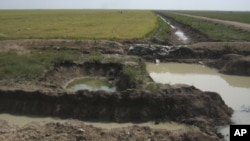Cambodia is building up its rural infrastructure in an effort to link itself to its neighbors, under an “economic corridor” project aided by the Asian Development Bank.
Proponents of the southern economic corridor, part of the Greater Mekong Subregion project, say it will bring benefits to villagers like those in Kampong Thom district’s Sambo Prey Kuk temple, in Prasat Sambo district.
Here, a bumpy dirty road connecting the temple to the main provincial town was recently improved.
“When the road was rough, not many people came,” said Kong Sophy, who owns a restaurant near the ancient temple, where buses of tourists now visit. “But now that the road is good, more visitors are coming. So I do well in sales.”
Tem Bunteng, a local tour guide, agrees that better infrastructure has improved tourism numbers to the temple, which is one of the most-visited temples in the country outside those of Angkor Wat.
“The people here want a good road because it can bring in more tourists,” Tem Bunteng said.
“It’s very important because this is one of the most attractive spots in the country,” Ingrid Overstegen, a Dutch tourist said one afternoon at the temple. “Tourists want to come here, and they bring money to your country, so it's good for your economy.”
Economists say the connection between rural and urban areas across borders in the Mekong countries can help boost economies across the region.
“There's a huge potential in tourism and agriculture,” Arjun Goswami, the ADB’s director for regional cooperation, said in an interview during a regional forum on the economic corridor last month. “Now, both of these sectors, in terms of cross-border movement of people or cross-border movement of agricultural goods and produce, depend on the husbanding of natural resources.”
However, that potential can also bring some strife to communities who say they are not benefiting.
That has been the case for 500 villagers from the Prey Lang forest, which spans four eastern provinces and is the site of at least two large rubber plantation concessions to Vietnamese companies. Villagers say the cross-border concessions are threatening their livelihoods from the large expanse of natural forest.
While tourists were admiring Sambo Prey Kuk temple earlier this month, these villagers were holding a forum in Kampong Thom to express their grievances.
“The other 20 provinces know clearly that in history, there are no other forests left in Cambodia,” Ros Soeunn, a 77-year-old villager told the forum, which had gathered under a tent in Kampong Thom town.
“Only this Prey Lang still exists,” he shouted into a microphone at a gathering of lawmakers and local authorities. “Do you want to destroy it all? And where can the people live?”
“You give companies millions of hectares, but your own people, nothing,” he said. “You just allow others from outside to develop, but what is development for, if the people weep bitterly?”
Goswami said the risks that may come from increased development will have to be addressed.
“Of course countries that have natural resources will want to use that natural resource base for growth, and other countries will want to get access to it,” he said, referring to agricultural development in general. “The issue is not trying to stop it; the issue is trying to make sure that the risks are best mitigated.”




